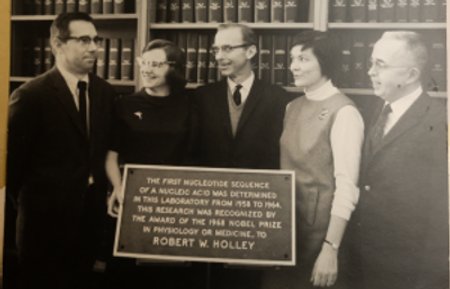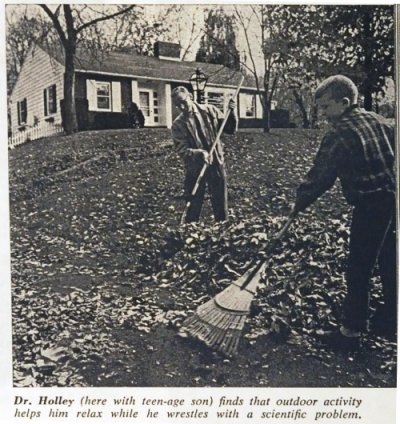| Robert W. Holley Biography |

|

Career
Robert W. Holley was born in Urbana, Illinois, on January 28th, 1922, one of four sons of Charles and Viola Holley. His parents were both educators. He attended public schools in Illinois, California and Idaho, and graduated from Urbana High School in 1938. He studied chemistry at the University of Illinois and received his B. A. degree in 1942. He obtained the Ph.D. at Cornell University with Professor Alfred T. Blomquist in 1947. The Second World War interrupted his own research but caused him to spend two years, 1944-1946, at Cornell University Medical College with Professor Vincent du Vigneaud, where he participated in the first chemical synthesis of penicillin. Prof. du Vigneaud would go on to win the Nobel Prize for Chemistry in 1955.
Holley spent 1947-1948 as an American Chemical Society Postdoctoral Fellow with Professor Carl M. Stevens at Washington State University. He then returned to Cornell University as Assistant Professor of Organic Chemistry at the Geneva Experiment Station in 1948. He was Associate Professor there from 1950-1957. During a sabbatical year, 1955-1956, he was a Guggenheim Memorial Fellow with James F. Bonner at the California Institute of Technology. In 1958, he returned to Ithaca, New York, as a Research Chemist for the United States Department of Agriculture, Agricultural Research Service at the U. S. Plant, Soil and Nutrition Laboratory on the Cornell University campus. He rejoined the faculty of Cornell University in 1964 as Professor of Biochemistry and Molecular Biology, and was Chairman of the Department from 1965 to 1966. He spent the following year, 1966-1967, at the Salk Institute for Biological Studies and the Scripps Clinic and Research Foundation in La Jolla, California, as a National Science Foundation Postdoctoral Fellow. In 1968, though maintaining an affiliation with Cornell University, he joined the permanent staff of the Salk Institute, where he was a Resident Fellow and an American Cancer Society Professor of Molecular Biology. He was also an Adjunct Professor at the University of California at San Diego.
The seeds of Holley's interest in transfer RNA (tRNA) were planted during his sabbatical at the California Institute of Technology where he studied protein synthesis. In particular, he sought to identify the molecule accepting activated amino acids that were to be incorporated into a protein. This work led to the discovery of the alanine tRNA. The following 10 years were spent working with this RNA, first concentrating on the isolation of the RNA, and then working on the determination of the structure of the RNA. The nucleotide sequence was completed at the end of 1964 and was a key discovery in explaining the synthesis of proteins from messenger RNA. In particular, the work led Holley's team to speculate on the folding of the tRNA molecule that exposed the anti-codon for the amino acid alanine. The structure of tRNA molecules for other amino acids were rapidly elucidated in other labs and showed sequences capable of the same folding pattern. It was for this work that Holley was awarded the Nobel Prize for Physiology or Medicine in 1968. His later work was concerned with factors that control cell division in mammalian cells.
Holley received the Albert Lasker Award in Basic Medical Research in 1965, the Distinguished Service Award of the U. S. Department of Agriculture in 1965, the U. S. Steel Foundation Award in Molecular Biology of the National Academy of Sciences in 1967, and was elected member of the National Academy of Sciences in 1968. He was also a member of the American Academy of Arts and Sciences, the American Association for the Advancement of Science, The American Society of Biological Chemists and the American Chemical Society. In 1990, he was inducted into the ARS Hall of Fame.
Robert W. Holley died on February 11, 1993.
[Modified from Les Prix Nobel en 1968, Editor Wilhelm Odelberg, (Nobel Foundation), Stockholm, 1969. This biography was written at the time of the award and later published in the book series Les Prix Nobel/Nobel Lectures.]

From left to right: James Madison, Jean Apgar, Robert Holley,
Susan Merrill, George Everett.
Science
The essential approach taken to sequencing the alanine tRNA follows.
- Break up the whole molecule into many small fragments using each of two nucleases. The nucleases chosen, pancreatic ribonuclease and takadiastase ribonuclease T1, cleave at different sites so that the small fragments from each digestion overlap.
- Snake venom phosphodiesterase can break each small fragment into a ladder of successively longer subfragments. The last nucleotide of each subfragment can be determined to sequence each small fragment (up to about five nucleotides).
- Comparison of the short sequences of fragments from the overlapping ribonuclease digests of Step 1, and the presence of a few unique modified nucleotides, already allow some consolidation of the small fragments into longer sequences.
- Using partial digestion of the whole molecule, generate large fragments. After chromatographic separation of the large fragments, they can each be degraded by ribonucleases into their small-fragment constituents. Each large fragment then becomes a logical ordering puzzle with certain possibilities ruled out by the composition of the small fragments. Overlap between the large fragments allows final assembly of the complete molecule.
In the process, several crucial techniques were invented or perfected. Prior to Holley's work, there was no way to purify tRNAs. Indeed, there was not even certainty at the outset of their sequencing effort that their alanine tRNA was pure. Nevertheless "there seemed no alternative but to gamble a few years of work on the problem hoping that the material was sufficiently pure for structural analysis. If the starting material was impure, we could expect that attempts at structural analysis would lead to hopeless confusion. Fortunately this was not the outcome." Over the course of their work, Holley and colleagues isolated tRNA from some 300 pounds of baker's yeast. Additionally, important refinements of chromatography were needed to separate oligonucleotide fragments generated by partial degradation in very small amounts.
Despite the vast difference of scale between Holley's work and current-day sequencing, there are obvious commonalities between the methods he used and sequence assembly methods used today.
Holley's Science paper:
Structure of a Ribonucleic Acid, Science, 147 (1965) 1462-1465 Robert W. Holley , Jean Apgar, George A. Everett, James T. Madison, Mark Marquisee, Susan H. Merrill, John Robert Penswick, and Ada Zamir U.S. Plant, Soil, and Nutrition Laboratory, U.S. Department of Agriculture, and Department of Biochemistry, Cornell University, Ithaca, New York doi:10.1126/science.147.3664.1462
Full Abstract:
The complete nucleotide sequence of an alanine transfer RNA, isolated from yeast, has been determined. This is the first nucleic acid for which the structure is known.

Holley's personal reflections on his science
"At the time that the isolation of the alanine RNA was undertaken, it was not known whether an individual nucleic acid could be isolated from a complex mixture of nucleic acids. Once individual transfer RNA's were isolated, it was not known whether a nucleic acid structure could be determined. In retrospect, the part of the structure determination that was completely uncharted, namely the determination of long nucleotide sequences, turned out to be easier than was anticipated."
"The satisfaction was increased by the fact that we were able to work with the alanine transfer RNA from discovery to isolation to structural analysis. In these times of highly competitive research, few scientists have the satisfaction of carrying through a research problem that takes 9 years. Without minimizing the pleasure of receiving awards and prizes, I think it is true that the greatest satisfaction for a scientist comes from carrying a major piece of research to a successful conclusion."
[At the close of his Nobel acceptance lecture] "That then is our story of the alanine transfer RNA. It all followed quite naturally from taking a sabbatical leave. I strongly recommend sabbatical leaves."
"Special thanks are due Dr. W. H. Allaway, Director of the U. S. Plant, Soil and Nutrition Laboratory, for his confidence and encouragement throughout the sequence determination."
"With Allaway's foresight, we were able to use hard money initially to get the pioneering work done, and then get grants and fellowships to expand the work - the best of both worlds ... The moral is to have good administrators - much easier said than done." [W.H. Allaway was director of the U.S. Plant Soil and Nutrition Laboratory at the time Holley worked there.]

